Nursing 1 Assignment: Scope of Practice and Addiction Nursing
VerifiedAdded on 2022/10/17
|6
|1736
|13
Essay
AI Summary
This essay delves into the scope of practice within nursing, particularly in Australia, emphasizing the roles and responsibilities of registered nurses (RNs). It defines scope of practice as the range of duties and activities certified nurses are trained to perform, with the primary goal of optimizing patient health and quality of life. The essay highlights the seven standards outlined by the Nursing and Midwifery Board of Australia (2017), including critical thinking, therapeutic relationships, maintaining capability for practice, assessment, planning, quality nursing practice provision, and result assessment. The author expresses a desire to become a Certified Addiction Registered Nurse (CARN), motivated by personal experiences and observations of rising drug addiction cases among young people in Australia. The essay discusses the roles of a CARN, including effective communication, empathy, and stress management, and outlines intervention strategies such as screening, family involvement, and behavioral strategies, aligning with the RN's scope of practice to provide safe and quality care. The author supports these approaches with research and emphasizes the importance of addressing the increasing burden of drug addiction in Australia.
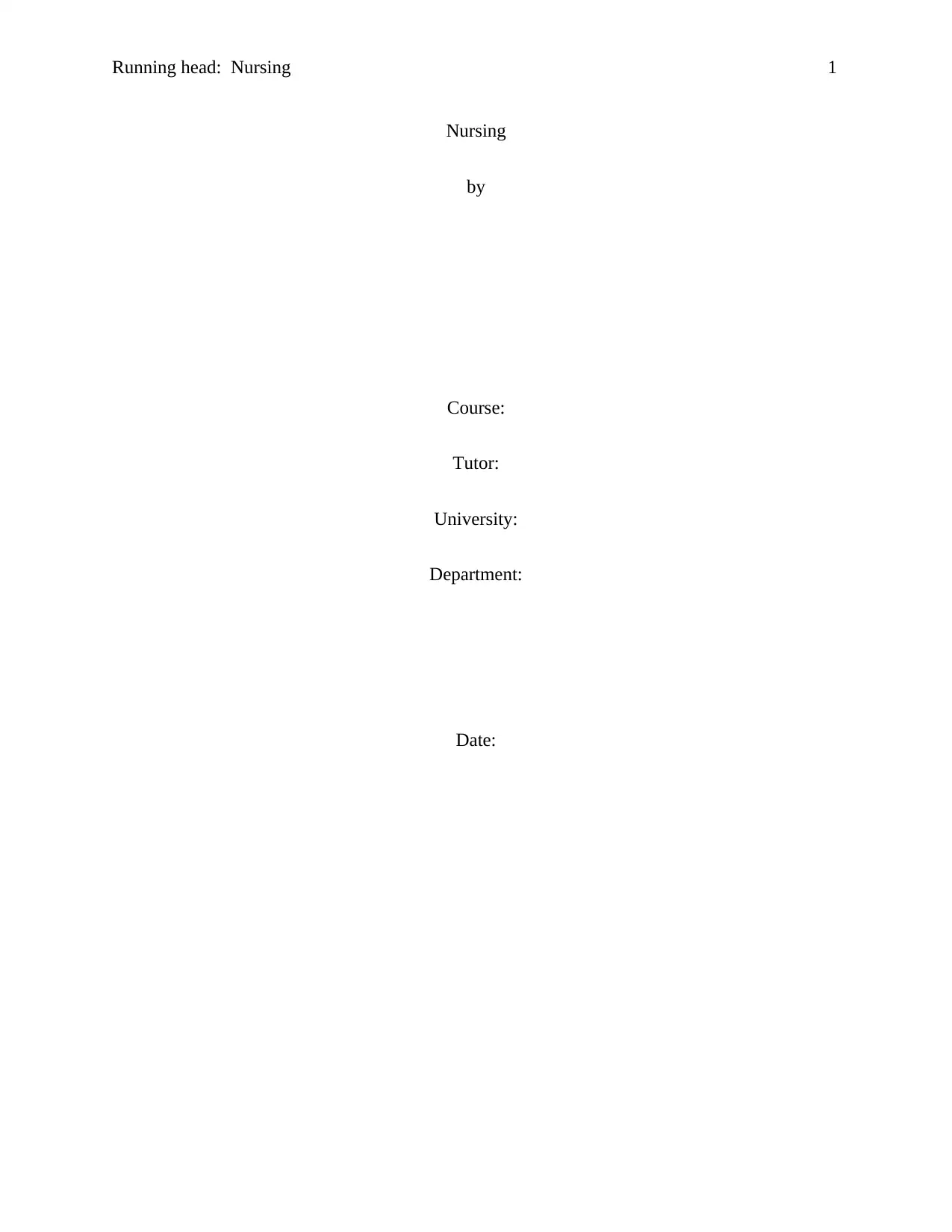
Running head: Nursing 1
Nursing
by
Course:
Tutor:
University:
Department:
Date:
Nursing
by
Course:
Tutor:
University:
Department:
Date:
Paraphrase This Document
Need a fresh take? Get an instant paraphrase of this document with our AI Paraphraser
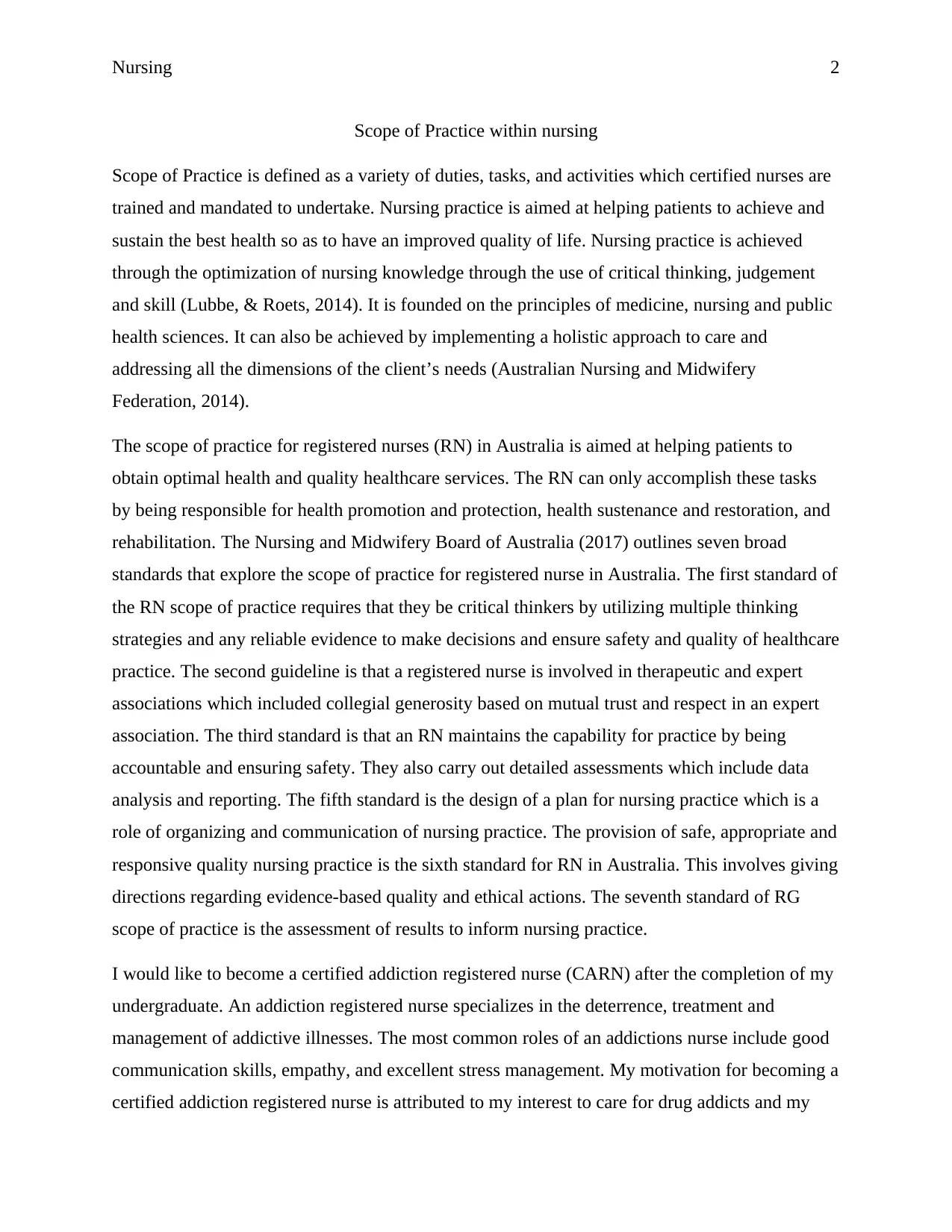
Nursing 2
Scope of Practice within nursing
Scope of Practice is defined as a variety of duties, tasks, and activities which certified nurses are
trained and mandated to undertake. Nursing practice is aimed at helping patients to achieve and
sustain the best health so as to have an improved quality of life. Nursing practice is achieved
through the optimization of nursing knowledge through the use of critical thinking, judgement
and skill (Lubbe, & Roets, 2014). It is founded on the principles of medicine, nursing and public
health sciences. It can also be achieved by implementing a holistic approach to care and
addressing all the dimensions of the client’s needs (Australian Nursing and Midwifery
Federation, 2014).
The scope of practice for registered nurses (RN) in Australia is aimed at helping patients to
obtain optimal health and quality healthcare services. The RN can only accomplish these tasks
by being responsible for health promotion and protection, health sustenance and restoration, and
rehabilitation. The Nursing and Midwifery Board of Australia (2017) outlines seven broad
standards that explore the scope of practice for registered nurse in Australia. The first standard of
the RN scope of practice requires that they be critical thinkers by utilizing multiple thinking
strategies and any reliable evidence to make decisions and ensure safety and quality of healthcare
practice. The second guideline is that a registered nurse is involved in therapeutic and expert
associations which included collegial generosity based on mutual trust and respect in an expert
association. The third standard is that an RN maintains the capability for practice by being
accountable and ensuring safety. They also carry out detailed assessments which include data
analysis and reporting. The fifth standard is the design of a plan for nursing practice which is a
role of organizing and communication of nursing practice. The provision of safe, appropriate and
responsive quality nursing practice is the sixth standard for RN in Australia. This involves giving
directions regarding evidence-based quality and ethical actions. The seventh standard of RG
scope of practice is the assessment of results to inform nursing practice.
I would like to become a certified addiction registered nurse (CARN) after the completion of my
undergraduate. An addiction registered nurse specializes in the deterrence, treatment and
management of addictive illnesses. The most common roles of an addictions nurse include good
communication skills, empathy, and excellent stress management. My motivation for becoming a
certified addiction registered nurse is attributed to my interest to care for drug addicts and my
Scope of Practice within nursing
Scope of Practice is defined as a variety of duties, tasks, and activities which certified nurses are
trained and mandated to undertake. Nursing practice is aimed at helping patients to achieve and
sustain the best health so as to have an improved quality of life. Nursing practice is achieved
through the optimization of nursing knowledge through the use of critical thinking, judgement
and skill (Lubbe, & Roets, 2014). It is founded on the principles of medicine, nursing and public
health sciences. It can also be achieved by implementing a holistic approach to care and
addressing all the dimensions of the client’s needs (Australian Nursing and Midwifery
Federation, 2014).
The scope of practice for registered nurses (RN) in Australia is aimed at helping patients to
obtain optimal health and quality healthcare services. The RN can only accomplish these tasks
by being responsible for health promotion and protection, health sustenance and restoration, and
rehabilitation. The Nursing and Midwifery Board of Australia (2017) outlines seven broad
standards that explore the scope of practice for registered nurse in Australia. The first standard of
the RN scope of practice requires that they be critical thinkers by utilizing multiple thinking
strategies and any reliable evidence to make decisions and ensure safety and quality of healthcare
practice. The second guideline is that a registered nurse is involved in therapeutic and expert
associations which included collegial generosity based on mutual trust and respect in an expert
association. The third standard is that an RN maintains the capability for practice by being
accountable and ensuring safety. They also carry out detailed assessments which include data
analysis and reporting. The fifth standard is the design of a plan for nursing practice which is a
role of organizing and communication of nursing practice. The provision of safe, appropriate and
responsive quality nursing practice is the sixth standard for RN in Australia. This involves giving
directions regarding evidence-based quality and ethical actions. The seventh standard of RG
scope of practice is the assessment of results to inform nursing practice.
I would like to become a certified addiction registered nurse (CARN) after the completion of my
undergraduate. An addiction registered nurse specializes in the deterrence, treatment and
management of addictive illnesses. The most common roles of an addictions nurse include good
communication skills, empathy, and excellent stress management. My motivation for becoming a
certified addiction registered nurse is attributed to my interest to care for drug addicts and my
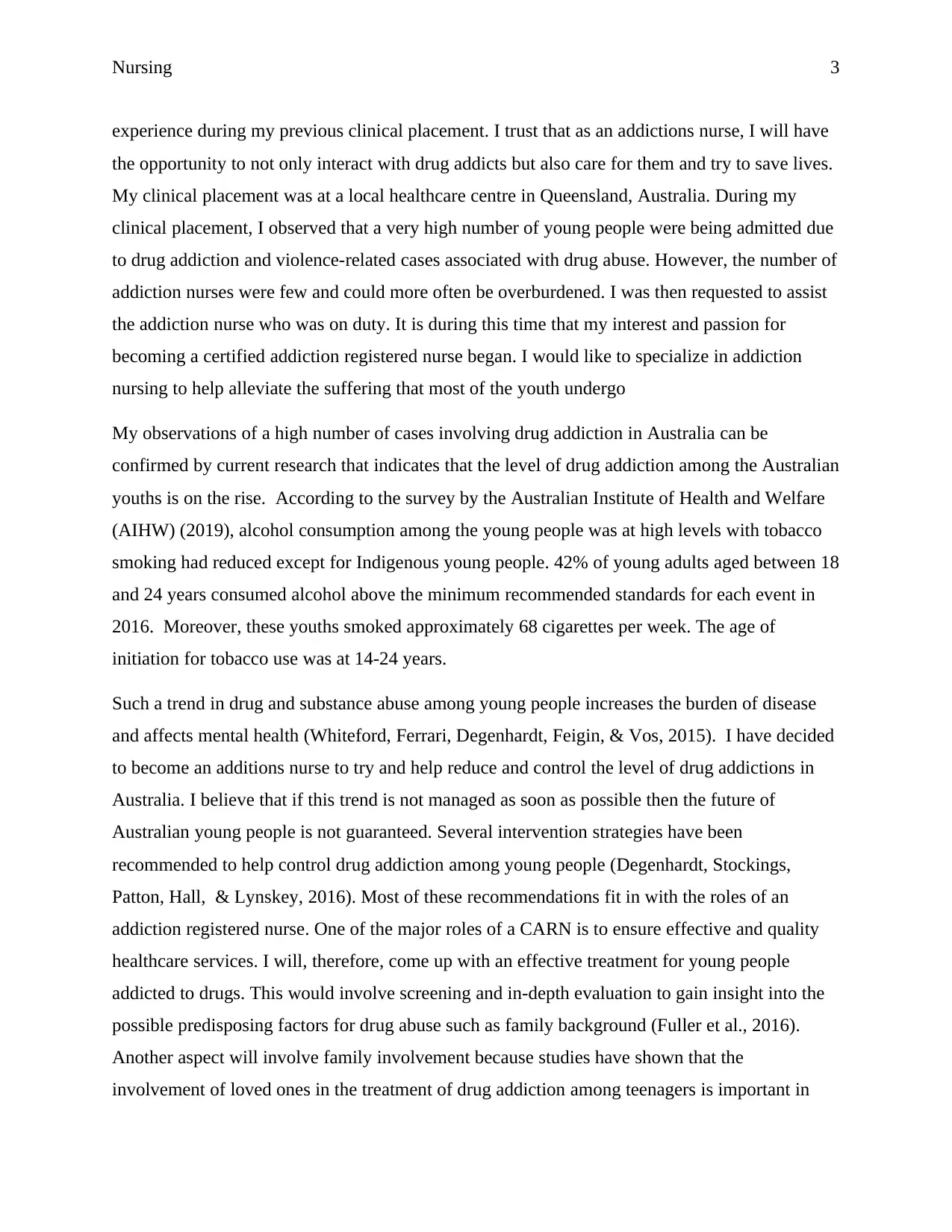
Nursing 3
experience during my previous clinical placement. I trust that as an addictions nurse, I will have
the opportunity to not only interact with drug addicts but also care for them and try to save lives.
My clinical placement was at a local healthcare centre in Queensland, Australia. During my
clinical placement, I observed that a very high number of young people were being admitted due
to drug addiction and violence-related cases associated with drug abuse. However, the number of
addiction nurses were few and could more often be overburdened. I was then requested to assist
the addiction nurse who was on duty. It is during this time that my interest and passion for
becoming a certified addiction registered nurse began. I would like to specialize in addiction
nursing to help alleviate the suffering that most of the youth undergo
My observations of a high number of cases involving drug addiction in Australia can be
confirmed by current research that indicates that the level of drug addiction among the Australian
youths is on the rise. According to the survey by the Australian Institute of Health and Welfare
(AIHW) (2019), alcohol consumption among the young people was at high levels with tobacco
smoking had reduced except for Indigenous young people. 42% of young adults aged between 18
and 24 years consumed alcohol above the minimum recommended standards for each event in
2016. Moreover, these youths smoked approximately 68 cigarettes per week. The age of
initiation for tobacco use was at 14-24 years.
Such a trend in drug and substance abuse among young people increases the burden of disease
and affects mental health (Whiteford, Ferrari, Degenhardt, Feigin, & Vos, 2015). I have decided
to become an additions nurse to try and help reduce and control the level of drug addictions in
Australia. I believe that if this trend is not managed as soon as possible then the future of
Australian young people is not guaranteed. Several intervention strategies have been
recommended to help control drug addiction among young people (Degenhardt, Stockings,
Patton, Hall, & Lynskey, 2016). Most of these recommendations fit in with the roles of an
addiction registered nurse. One of the major roles of a CARN is to ensure effective and quality
healthcare services. I will, therefore, come up with an effective treatment for young people
addicted to drugs. This would involve screening and in-depth evaluation to gain insight into the
possible predisposing factors for drug abuse such as family background (Fuller et al., 2016).
Another aspect will involve family involvement because studies have shown that the
involvement of loved ones in the treatment of drug addiction among teenagers is important in
experience during my previous clinical placement. I trust that as an addictions nurse, I will have
the opportunity to not only interact with drug addicts but also care for them and try to save lives.
My clinical placement was at a local healthcare centre in Queensland, Australia. During my
clinical placement, I observed that a very high number of young people were being admitted due
to drug addiction and violence-related cases associated with drug abuse. However, the number of
addiction nurses were few and could more often be overburdened. I was then requested to assist
the addiction nurse who was on duty. It is during this time that my interest and passion for
becoming a certified addiction registered nurse began. I would like to specialize in addiction
nursing to help alleviate the suffering that most of the youth undergo
My observations of a high number of cases involving drug addiction in Australia can be
confirmed by current research that indicates that the level of drug addiction among the Australian
youths is on the rise. According to the survey by the Australian Institute of Health and Welfare
(AIHW) (2019), alcohol consumption among the young people was at high levels with tobacco
smoking had reduced except for Indigenous young people. 42% of young adults aged between 18
and 24 years consumed alcohol above the minimum recommended standards for each event in
2016. Moreover, these youths smoked approximately 68 cigarettes per week. The age of
initiation for tobacco use was at 14-24 years.
Such a trend in drug and substance abuse among young people increases the burden of disease
and affects mental health (Whiteford, Ferrari, Degenhardt, Feigin, & Vos, 2015). I have decided
to become an additions nurse to try and help reduce and control the level of drug addictions in
Australia. I believe that if this trend is not managed as soon as possible then the future of
Australian young people is not guaranteed. Several intervention strategies have been
recommended to help control drug addiction among young people (Degenhardt, Stockings,
Patton, Hall, & Lynskey, 2016). Most of these recommendations fit in with the roles of an
addiction registered nurse. One of the major roles of a CARN is to ensure effective and quality
healthcare services. I will, therefore, come up with an effective treatment for young people
addicted to drugs. This would involve screening and in-depth evaluation to gain insight into the
possible predisposing factors for drug abuse such as family background (Fuller et al., 2016).
Another aspect will involve family involvement because studies have shown that the
involvement of loved ones in the treatment of drug addiction among teenagers is important in
⊘ This is a preview!⊘
Do you want full access?
Subscribe today to unlock all pages.

Trusted by 1+ million students worldwide
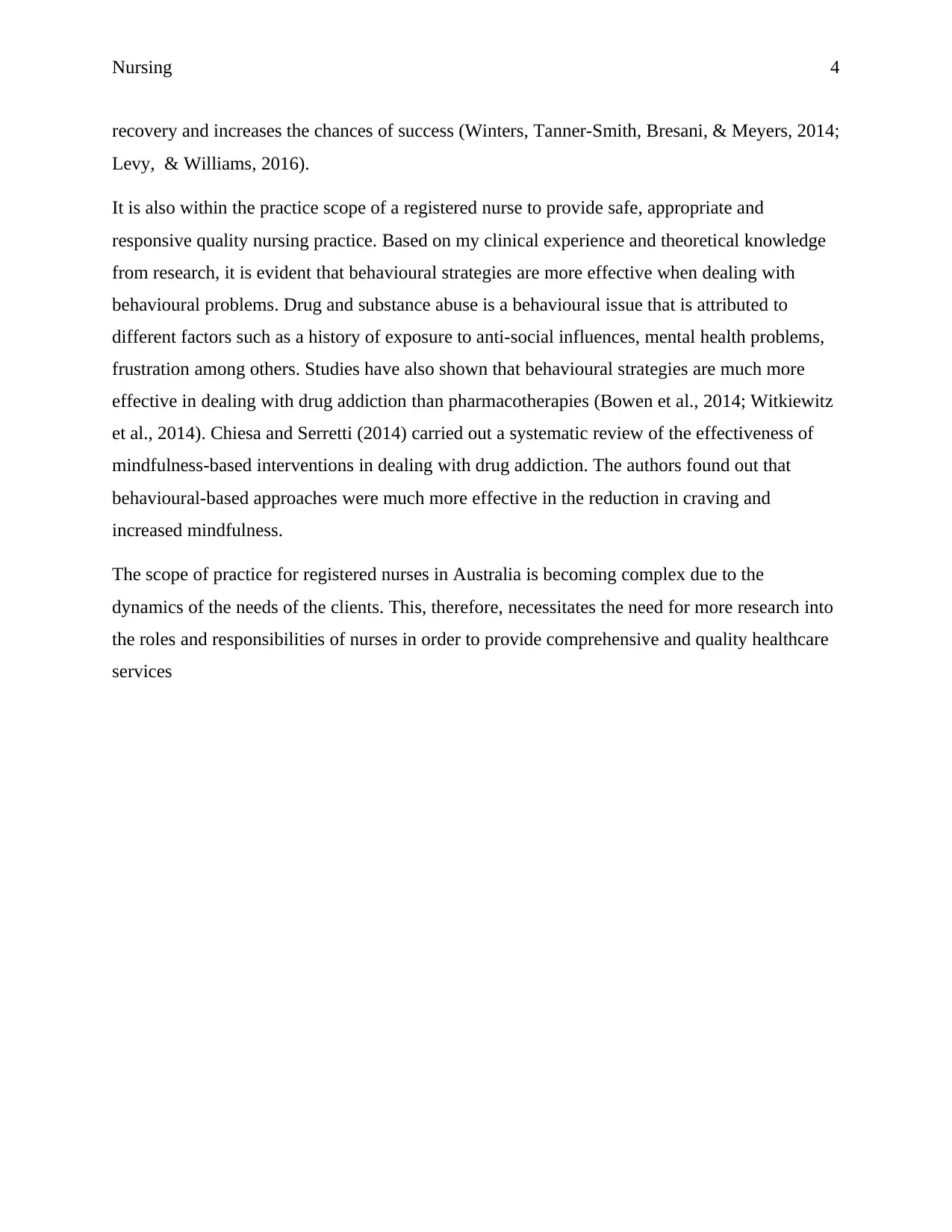
Nursing 4
recovery and increases the chances of success (Winters, Tanner-Smith, Bresani, & Meyers, 2014;
Levy, & Williams, 2016).
It is also within the practice scope of a registered nurse to provide safe, appropriate and
responsive quality nursing practice. Based on my clinical experience and theoretical knowledge
from research, it is evident that behavioural strategies are more effective when dealing with
behavioural problems. Drug and substance abuse is a behavioural issue that is attributed to
different factors such as a history of exposure to anti-social influences, mental health problems,
frustration among others. Studies have also shown that behavioural strategies are much more
effective in dealing with drug addiction than pharmacotherapies (Bowen et al., 2014; Witkiewitz
et al., 2014). Chiesa and Serretti (2014) carried out a systematic review of the effectiveness of
mindfulness-based interventions in dealing with drug addiction. The authors found out that
behavioural-based approaches were much more effective in the reduction in craving and
increased mindfulness.
The scope of practice for registered nurses in Australia is becoming complex due to the
dynamics of the needs of the clients. This, therefore, necessitates the need for more research into
the roles and responsibilities of nurses in order to provide comprehensive and quality healthcare
services
recovery and increases the chances of success (Winters, Tanner-Smith, Bresani, & Meyers, 2014;
Levy, & Williams, 2016).
It is also within the practice scope of a registered nurse to provide safe, appropriate and
responsive quality nursing practice. Based on my clinical experience and theoretical knowledge
from research, it is evident that behavioural strategies are more effective when dealing with
behavioural problems. Drug and substance abuse is a behavioural issue that is attributed to
different factors such as a history of exposure to anti-social influences, mental health problems,
frustration among others. Studies have also shown that behavioural strategies are much more
effective in dealing with drug addiction than pharmacotherapies (Bowen et al., 2014; Witkiewitz
et al., 2014). Chiesa and Serretti (2014) carried out a systematic review of the effectiveness of
mindfulness-based interventions in dealing with drug addiction. The authors found out that
behavioural-based approaches were much more effective in the reduction in craving and
increased mindfulness.
The scope of practice for registered nurses in Australia is becoming complex due to the
dynamics of the needs of the clients. This, therefore, necessitates the need for more research into
the roles and responsibilities of nurses in order to provide comprehensive and quality healthcare
services
Paraphrase This Document
Need a fresh take? Get an instant paraphrase of this document with our AI Paraphraser
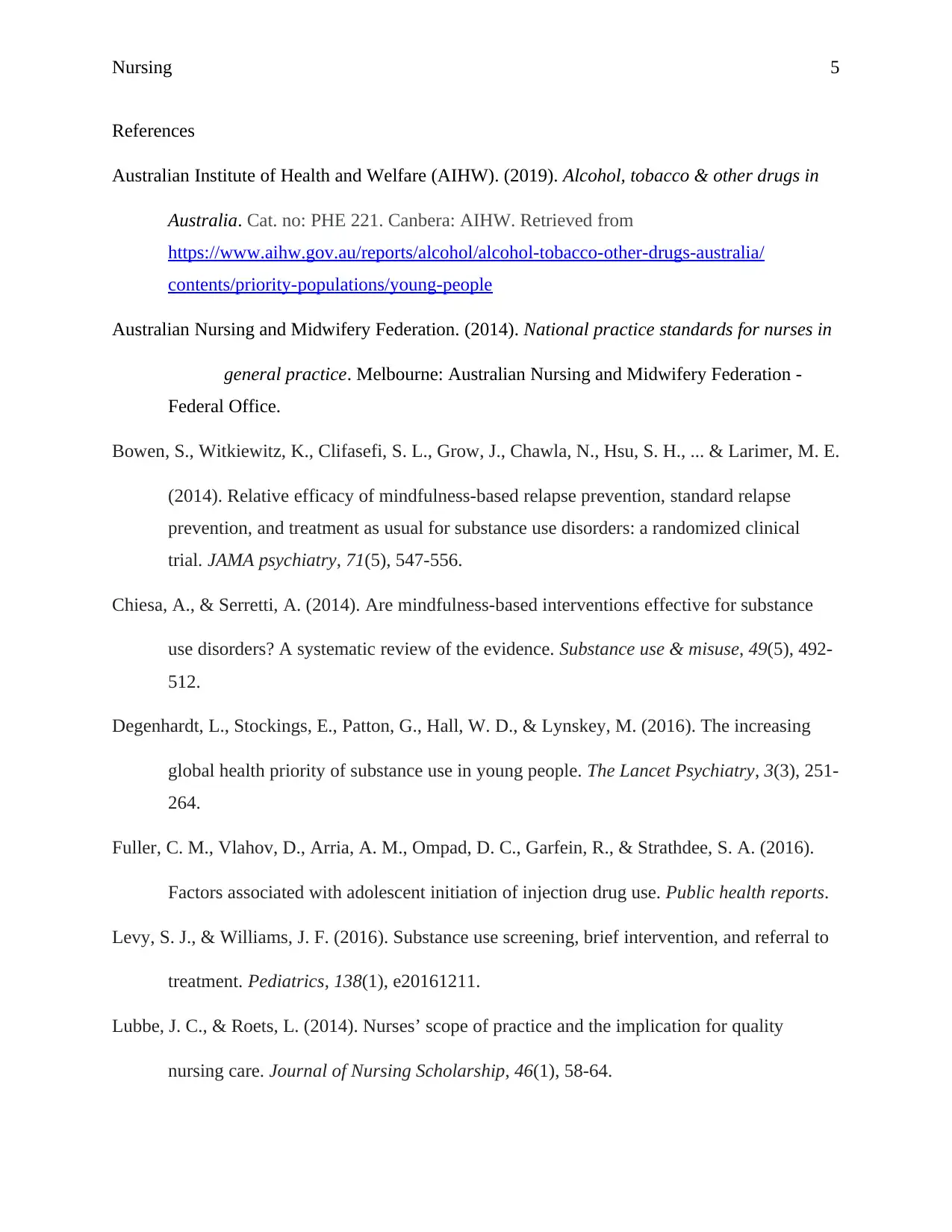
Nursing 5
References
Australian Institute of Health and Welfare (AIHW). (2019). Alcohol, tobacco & other drugs in
Australia. Cat. no: PHE 221. Canbera: AIHW. Retrieved from
https://www.aihw.gov.au/reports/alcohol/alcohol-tobacco-other-drugs-australia/
contents/priority-populations/young-people
Australian Nursing and Midwifery Federation. (2014). National practice standards for nurses in
general practice. Melbourne: Australian Nursing and Midwifery Federation -
Federal Office.
Bowen, S., Witkiewitz, K., Clifasefi, S. L., Grow, J., Chawla, N., Hsu, S. H., ... & Larimer, M. E.
(2014). Relative efficacy of mindfulness-based relapse prevention, standard relapse
prevention, and treatment as usual for substance use disorders: a randomized clinical
trial. JAMA psychiatry, 71(5), 547-556.
Chiesa, A., & Serretti, A. (2014). Are mindfulness-based interventions effective for substance
use disorders? A systematic review of the evidence. Substance use & misuse, 49(5), 492-
512.
Degenhardt, L., Stockings, E., Patton, G., Hall, W. D., & Lynskey, M. (2016). The increasing
global health priority of substance use in young people. The Lancet Psychiatry, 3(3), 251-
264.
Fuller, C. M., Vlahov, D., Arria, A. M., Ompad, D. C., Garfein, R., & Strathdee, S. A. (2016).
Factors associated with adolescent initiation of injection drug use. Public health reports.
Levy, S. J., & Williams, J. F. (2016). Substance use screening, brief intervention, and referral to
treatment. Pediatrics, 138(1), e20161211.
Lubbe, J. C., & Roets, L. (2014). Nurses’ scope of practice and the implication for quality
nursing care. Journal of Nursing Scholarship, 46(1), 58-64.
References
Australian Institute of Health and Welfare (AIHW). (2019). Alcohol, tobacco & other drugs in
Australia. Cat. no: PHE 221. Canbera: AIHW. Retrieved from
https://www.aihw.gov.au/reports/alcohol/alcohol-tobacco-other-drugs-australia/
contents/priority-populations/young-people
Australian Nursing and Midwifery Federation. (2014). National practice standards for nurses in
general practice. Melbourne: Australian Nursing and Midwifery Federation -
Federal Office.
Bowen, S., Witkiewitz, K., Clifasefi, S. L., Grow, J., Chawla, N., Hsu, S. H., ... & Larimer, M. E.
(2014). Relative efficacy of mindfulness-based relapse prevention, standard relapse
prevention, and treatment as usual for substance use disorders: a randomized clinical
trial. JAMA psychiatry, 71(5), 547-556.
Chiesa, A., & Serretti, A. (2014). Are mindfulness-based interventions effective for substance
use disorders? A systematic review of the evidence. Substance use & misuse, 49(5), 492-
512.
Degenhardt, L., Stockings, E., Patton, G., Hall, W. D., & Lynskey, M. (2016). The increasing
global health priority of substance use in young people. The Lancet Psychiatry, 3(3), 251-
264.
Fuller, C. M., Vlahov, D., Arria, A. M., Ompad, D. C., Garfein, R., & Strathdee, S. A. (2016).
Factors associated with adolescent initiation of injection drug use. Public health reports.
Levy, S. J., & Williams, J. F. (2016). Substance use screening, brief intervention, and referral to
treatment. Pediatrics, 138(1), e20161211.
Lubbe, J. C., & Roets, L. (2014). Nurses’ scope of practice and the implication for quality
nursing care. Journal of Nursing Scholarship, 46(1), 58-64.
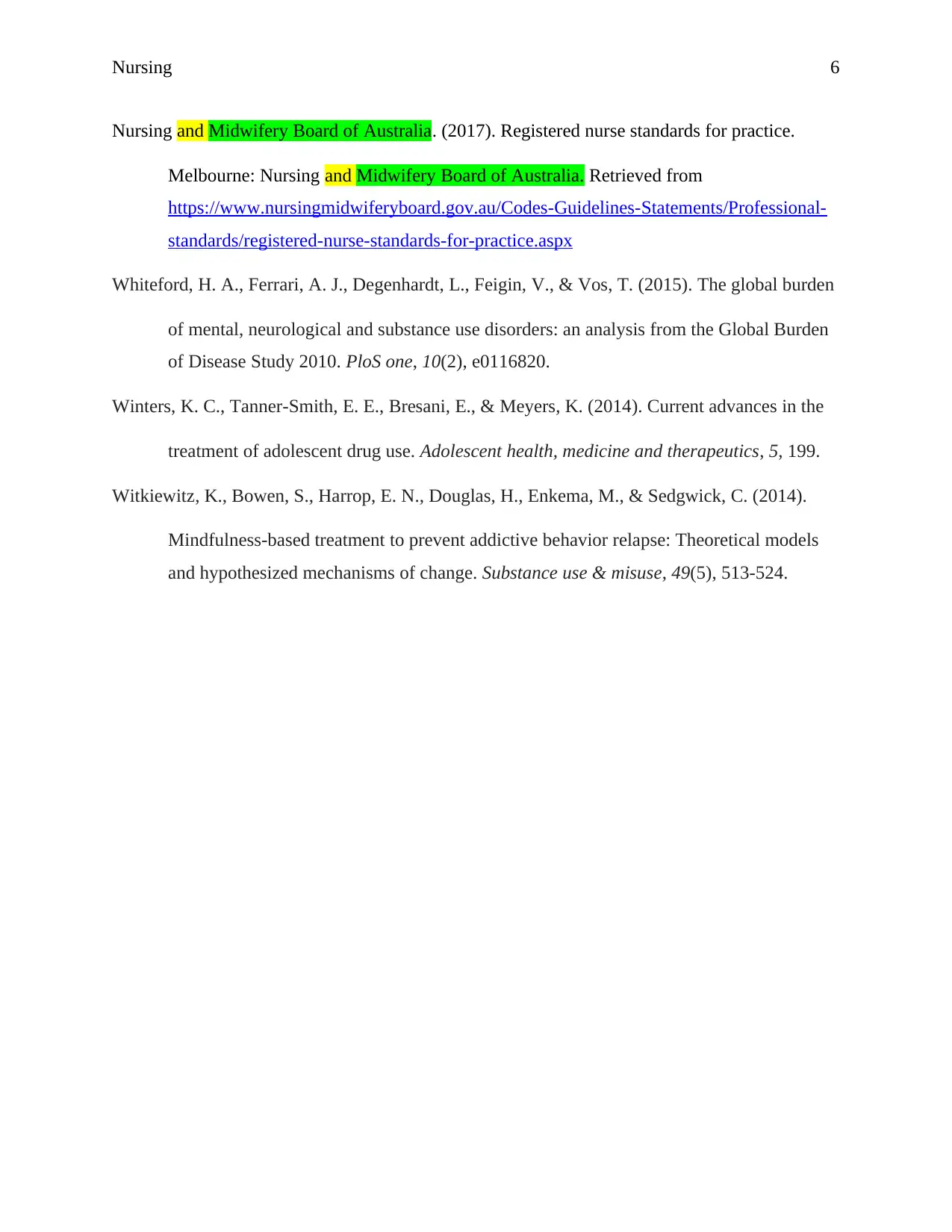
Nursing 6
Nursing and Midwifery Board of Australia. (2017). Registered nurse standards for practice.
Melbourne: Nursing and Midwifery Board of Australia. Retrieved from
https://www.nursingmidwiferyboard.gov.au/Codes-Guidelines-Statements/Professional-
standards/registered-nurse-standards-for-practice.aspx
Whiteford, H. A., Ferrari, A. J., Degenhardt, L., Feigin, V., & Vos, T. (2015). The global burden
of mental, neurological and substance use disorders: an analysis from the Global Burden
of Disease Study 2010. PloS one, 10(2), e0116820.
Winters, K. C., Tanner-Smith, E. E., Bresani, E., & Meyers, K. (2014). Current advances in the
treatment of adolescent drug use. Adolescent health, medicine and therapeutics, 5, 199.
Witkiewitz, K., Bowen, S., Harrop, E. N., Douglas, H., Enkema, M., & Sedgwick, C. (2014).
Mindfulness-based treatment to prevent addictive behavior relapse: Theoretical models
and hypothesized mechanisms of change. Substance use & misuse, 49(5), 513-524.
Nursing and Midwifery Board of Australia. (2017). Registered nurse standards for practice.
Melbourne: Nursing and Midwifery Board of Australia. Retrieved from
https://www.nursingmidwiferyboard.gov.au/Codes-Guidelines-Statements/Professional-
standards/registered-nurse-standards-for-practice.aspx
Whiteford, H. A., Ferrari, A. J., Degenhardt, L., Feigin, V., & Vos, T. (2015). The global burden
of mental, neurological and substance use disorders: an analysis from the Global Burden
of Disease Study 2010. PloS one, 10(2), e0116820.
Winters, K. C., Tanner-Smith, E. E., Bresani, E., & Meyers, K. (2014). Current advances in the
treatment of adolescent drug use. Adolescent health, medicine and therapeutics, 5, 199.
Witkiewitz, K., Bowen, S., Harrop, E. N., Douglas, H., Enkema, M., & Sedgwick, C. (2014).
Mindfulness-based treatment to prevent addictive behavior relapse: Theoretical models
and hypothesized mechanisms of change. Substance use & misuse, 49(5), 513-524.
⊘ This is a preview!⊘
Do you want full access?
Subscribe today to unlock all pages.

Trusted by 1+ million students worldwide
1 out of 6
Related Documents
Your All-in-One AI-Powered Toolkit for Academic Success.
+13062052269
info@desklib.com
Available 24*7 on WhatsApp / Email
![[object Object]](/_next/static/media/star-bottom.7253800d.svg)
Unlock your academic potential
Copyright © 2020–2025 A2Z Services. All Rights Reserved. Developed and managed by ZUCOL.





